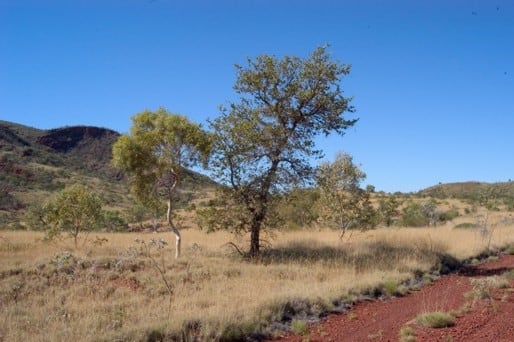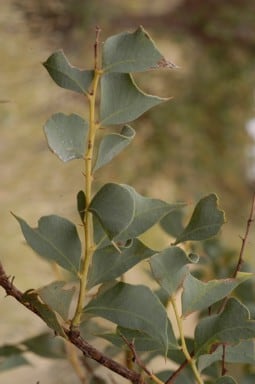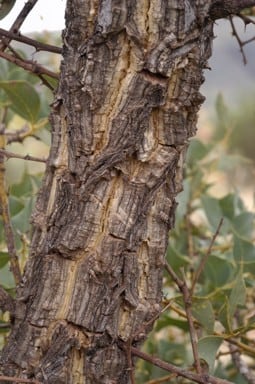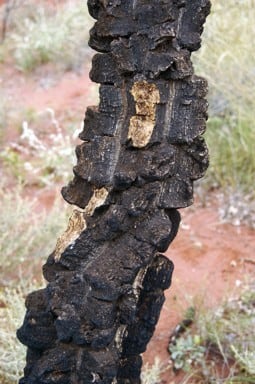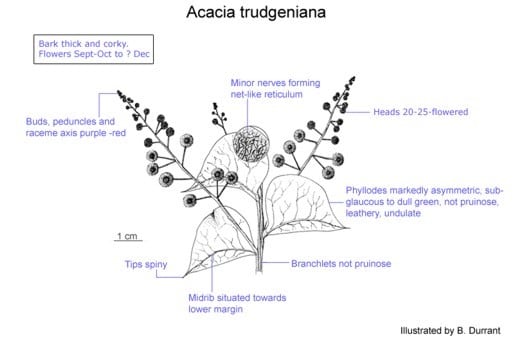Acacia trudgeniana Maslin
WATTLE
Acacias of Australia
Common Name
Trudgen’s Wattle
Family
Fabaceae
Distribution
Scattered in north-western W.A.; occurs from Winning and Yanrey Stn (near Exmouth Gulf) NE to Balfour Downs Stn, in the Millstream-Chichester Natl Park, S of Port Hedland and Barrow Is.
Description
Shrub (0.5–) 2–5 m high, with 1 or 2 straight or crooked main stems (plants appearing ±gnarled when stems crooked), lateral branches short and wide-spreading. Bark thick, corky. Branchlets glabrous, light brown to yellow tinged orange (often pale green at extremities), not pruinose. Stipules spinose but often only the bases persisting as blunt, knob-like protuberances with age, 4–8 mm long. Phyllodes inaequilaterally ovate to elliptic or rarely obovate, (15–) 30–50 mm long, (8–) 15–30 (–37) mm wide, undulate, short-acuminate, pungent, coriaceous, sub-glaucous ageing green, not pruinose; midrib prominent and situated near lower margin; minor nerves forming a close reticulum. Inflorescences (few seen) terminal or axillary racemes; raceme axes 3–15 cm long and (together with peduncles and flower buds) purple-red and glabrous; peduncles twinned (rarely 3), 7–20 (–25) mm long; heads globular, 20–25-flowered, light golden; buds dark purple-red. Flowers 5-merous; sepals ±free. Pods sub-straight to strongly curved, raised over seeds and slightly to moderately constricted between them, 2–5 cm long, 8–10 mm wide, thinly crustaceous, light brown, glabrous. Seeds (few seen) longitudinally oblique, oblong-elliptic to ±globose, c. 5 mm long, c. 4 mm wide, dark brown; areole very small; funicle rather thick, folded below seed, not or scarcely expanded into an aril.
Phenology
Flowers Sept./Oct. to perhaps Dec.
Habitat
Grows in sand or loam on flat or low-undulating plains with spinifex ground cover.
Specimens
W.A.: N of Winning Pool, C.A.Gardner 6232 (PERTH); Balfour Downs Stn, B.R.Maslin 8541 (PERTH); Yanrey Stn (S of Onslow), B.R.Maslin 8636A (NSW, NT, PERTH); Barrow Is., B.R.Maslin 8800 (PERTH); 4.3 km NW of Mt Montagu, M.E.Trudgen MET 15011 (PERTH).
Notes
A dwarf form occurs at one site on Barrow Is.; its phyllodes are smaller than normal (15–25 x 8–10 mm).
A member of the ‘A. pyrifolia group’, closely related to the more common A. inaequilatera which is most readily distinguished by its pruinose branchlets, often more blue-grey, pruinose phyllodes, slightly more flowers per head, generally more gnarled and diffuse growth form and earlier flowering period. These two species are easily confused because of their corky bark, spiny stipules, pungent, asymmetric phyllodes with midrib near lower margin and brightly coloured, raceme axes, peduncles and petals; they grow near one another but are not know to be sympatric. Acacia trudgeniana is also related to A. marramamba which differs in its non-corky bark, sparingly and openly anastomosing minor phyllode nerves and brownish red raceme axes, peduncles and flower buds.
A fire-tolerant species with its thick protective bark and its ability to resprout by epicormic growth following burns. Also has the capacity to resprout after the above ground biomass has been removed through bulldozing and other clearing operations.
FOA Reference
Flora of Australia Project
Author
B.R.Maslin, J.Reid
This identification key and fact sheets are available as a mobile application:
URL: https://apps.lucidcentral.org/wattle/
© Copyright 2018. All rights reserved.

